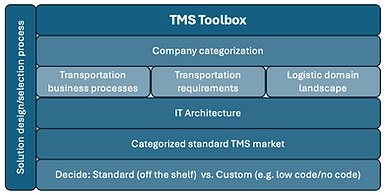


Software selection & implementation
In today’s supply chain landscape, both shippers and 3PLs increasingly rely on advanced technology to meet rising demands. As highlighted in the latest 3PL Study, solutions like Transportation Management Systems (TMS), Warehouse Management Systems (WMS), Order Management Systems (OMS), and Advanced Planning Systems (APS) are crucial for improving visibility, efficiency, and decision-making.
Selecting the right software is just as important as its implementation, ensuring that your systems are tailored to your specific needs and goals.
With extensive experience in logistics software selection and implementation, I use a proven toolbox that streamlines the entire selection process. This approach allows us to efficiently and effectively evaluate potential solutions, ensuring a quicker turnaround while aligning the chosen software with your operational and strategic objectives.
Ready to discover how selecting and implementing the right logistics software can transform your operations? Click here to learn more.
There is a wide range of reasons why companies might seek new software, from technical limitations and inefficiencies to strategic needs for growth, compliance, and modernization.
Approach to software selection
Selecting the right software is about more than just finding a tool that fits your current needs; it’s about finding a solution that can grow with your business and continue to deliver value over time. My approach to software selection is rooted in a comprehensive, step-by-step process:
-
Initial Process Analysis & Scoping:
Begin by conducting a detailed analysis of your current processes, identifying gaps and inefficiencies that new software needs to address. This includes reviewing both transportation and distribution workflows and any related upstream or downstream activities.
-
Requirements Definition:
Once the processes are mapped out, it’s critical to define your business requirements clearly. This step includes mapping business flows, analyzing data usage, and defining specific functionality that the new software must deliver. In doing so, you ensure that the software supports not only your current needs but also your long-term strategic goals.
-
IT architecture assessment
A critical element in selecting new software is understanding how it will fit within the broader IT landscape. The new TMS or WMS will not operate in isolation but will need to integrate with existing systems. This step involves reviewing the As-Is Information Systems Architecture, where we compile an inventory of current applications and their properties, as well as the interfaces that connect them. From there, we define the Target Architecture and Roadmap, specifying a feasible future state for the IT landscape and creating a roadmap for the transition.
-
Vendor Shortlisting and Evaluation:
Based on the defined requirements, I help businesses develop a shortlist of vendors whose solutions align with the functionality and scale needed. The evaluation process includes demonstrations, detailed analysis of each vendor’s capabilities, and considerations for scalability, integration, and support services.
-
Proof of Concept (PoC) and Testing:
The shortlisted vendors are invited to participate in a Proof of Concept (PoC), where the software is tested in a controlled environment to ensure it meets the specific requirements of the business. This stage is critical for verifying the system’s ability to handle your business processes before making a full commitment.
-
Decision-Making and Final Selection:
Once the PoC is complete, a comprehensive review of the vendor’s offering, support, and pricing is conducted to make an informed decision. This step also involves finalizing the deployment strategy—whether adopting a best-of-breed solution or an all-in-one suite.

USE of TMS Toolbox

Throughout the software selection process, which is outlined in the main steps above, I utilize a specialized TMS Toolbox. This toolbox is built from extensive experience gained during various implementations, as well as thorough research in the field. The TMS Toolbox accelerates key phases of the selection process, saving time, reducing costs, and ensuring high-quality outcomes.
For example, the toolbox includes a comprehensive overview of software vendors in the market, along with insights into the specific functionalities they offer. Additionally, it provides a pre-structured list of requirements tailored for each transport process, ensuring that no critical aspects are overlooked.
Implementing Logistics software
Implementing a new system is often regarded as one of the most challenging business transformations. Whether it's deploying an entirely new ERP, TMS or WMS solution or rolling out additional modules, these projects frequently struggle to meet their initial goals. Implementations are costly, both in terms of software and project execution, making failure a significant financial risk.
One key to success is appointing a dedicated project manager who can oversee the entire process and act as the bridge between your organization and external software vendors. Many companies struggle to free up internal resources for such time-intensive projects, as day-to-day operations must continue. An experienced external project manager can ensure that the project stays on track, on budget, and aligned with business goals. They bring expertise in managing vendor relationships and navigating the complexities that arise during these large-scale implementations.
By having a seasoned project manager at the helm, companies can reduce the risk of miscommunication, avoid common pitfalls, and ensure that employees remain engaged throughout the project. This helps prevent disruptions to operations and increases the likelihood of a successful ERP (or similar TMS/WMS) implementation.
Implementing Logistics Software (TMS, WMS, APS, SC Control Towers) is a complex journey that requires careful planning, coordination, and execution. Success hinges not only on selecting the right software but also on having the right implementation strategy. Whether you're working with major providers like SAP or Oracle, or looking for a custom, low code, no code (e.g. Mendix) solution, a structured, high-level implementation plan is key to aligning technology with business goals. Below is an overview of the critical phases in the implementation process, and how I can help ensure your project delivers maximum value.
High-Level Implementation Plan for Logistics Software
1. Project Kick-off and Team Setup
The implementation journey begins with forming the project team, including both the customer’s team and the vendor or implementation partner’s team (which is often the case for large TMS providers like SAP or Oracle). Despite the software vendor or implementation partner managing the project, it is crucial that the customer assigns their own experienced project manager and project team. This ensures that the project aligns with the business objectives and is executed efficiently. As an independent project manager, I can provide valuable oversight and coordination to keep the project on track.
2. Requirements Definition and Scope
This phase involves conducting workshops with key stakeholders to define the functional and technical requirements that the new system must meet. This includes analyzing current processes, understanding gaps, and setting clear goals for what the system needs to achieve. Having a pre-structured set of requirements, as found in the TMS Toolbox, can accelerate this phase significantly.
3. Vendor Configuration and Customization
Once the requirements are set, the software vendor or implementation partner begins configuring the system to meet the customer’s needs. Customization may be required if the standard functionality doesn’t fully align with the customer’s unique processes. Throughout this phase, the project team should ensure that all business-critical needs are addressed, and that any customizations are documented and agreed upon.
4. Data Migration and Integration
A critical step in any software implementation is ensuring seamless data migration from the old system to the new one. This includes validating the accuracy of historical data and ensuring smooth integration with existing systems such as Enterprise Resource Planning (ERP) or other supply chain management tools.
5. User Training and Change Management
Even the best software can fail without proper user adoption. The customer must invest in thorough user training to ensure that employees are comfortable with the new system. Additionally, a structured change management plan is essential to mitigate resistance and ensure a smooth transition to the new system. For more on managing these transitions, see my Project- and Change Management services.
6. Testing and Quality Assurance
Before going live, extensive testing of the new system is conducted. This includes User Acceptance Testing (UAT), where end-users validate that the system meets their daily operational needs. Any issues identified during testing are addressed before moving forward.
7. Go-Live and Hypercare
The go-live phase involves transitioning to the new system, often in a staged approach to minimize disruption. During this period, close monitoring is essential to address any teething problems and ensure that the system is functioning as intended. Hypercare, the phase immediately after go-live, ensures that any post-implementation issues are quickly resolved.
8. Post-Implementation Optimization
Once the system is live, ongoing support and system optimization are necessary. As business needs evolve, the software may need further adjustments or upgrades. Ensuring that system updates are implemented and that users continue to receive training as new features roll out is crucial for long-term success.